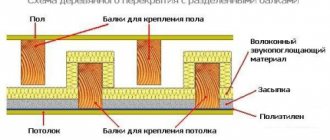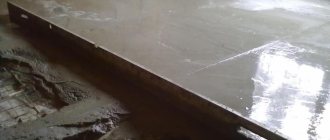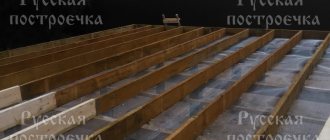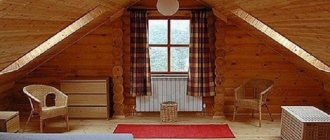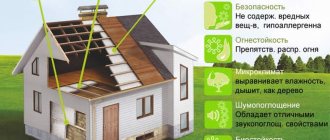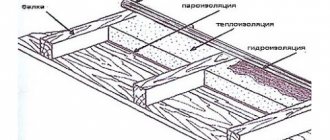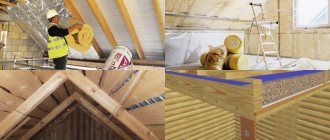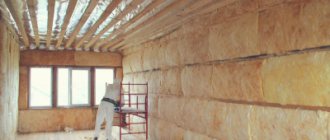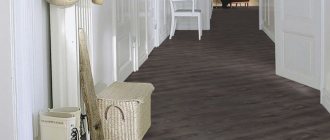- Floor insulation: which one is better to choose for a wooden house
- Choosing material for floor insulation
- How to properly insulate the floor in a wooden house with sawdust
- Subtleties of using mineral wool
- Features of using penofol
- Floor insulation with foam plastic
- Ecowool floor insulation
- Floor insulation with penoplex
- Using the "warm floor" system
- Tips for caring for insulated floors
- Floor insulation: which is the best manufacturer and how much does the material cost?
- Video: floor insulation in a frame house
Floor insulation: which one is better to choose for a wooden house
Floor insulation plays a very important role in the overall insulation of the house. It is best to do this at the construction stage, then for insulation you will not have to dismantle the existing floor covering, and the consumption of time, effort and building materials will be kept to a minimum. If you need to insulate the floor in an already inhabited house, then it will be somewhat more difficult. First you need to decide what will be used as floor insulation , which one is better to choose to create high thermal insulation in a wooden house.
Wooden floors in a private house: options for installation and insulation (read more)
Insulation of a wooden floor with glass wool.
Video of floor insulation in a wooden house
Insulation methods differ from each other. The attached videos will help you understand the intricacies of thermal insulation from below and from the inside of the house. The first video describes in detail the thermal insulation scheme and the purpose of each structural element. Any owner of a wooden cottage without a construction education will be able to figure out the installation process on their own after watching the video. The second video reveals the nuances of insulation from below.
You can insulate the floor in a house using different methods using slabs, rolls, and bulk materials. The choice in favor of one method or another depends on the location of the wooden structure, the condition of the house, and climatic conditions. In any case, do-it-yourself insulation must be done in accordance with the rules and building codes.
Choosing material for floor insulation
The selection of thermal insulation materials should be treated with maximum responsibility. In many ways, the choice will depend on the financial well-being of the home owner, but you should not save on insulation. Remember that heat loss is the consumption of excess electricity to heat your home, and this means additional financial expenses.
What is the best insulation for floors in a wooden house? You can find out by considering the advantages and disadvantages of each type of thermal insulation material.
Laying sheets of plywood on the joists and filling the voids with stone wool.
The most common materials for floor insulation today are:
- mineral wool;
- ecowool;
- wood sawdust;
- polyurethane foam;
- penofol;
- Styrofoam;
- expanded clay
The insulation is cut according to the size between the joists.
Each of these materials has its own characteristics, as well as installation nuances.
In order to choose the best way to insulate the floor in a wooden house, you should consider the following parameters:
- indoor conditions - average humidity and air temperature, extreme values of these indicators and the frequency of their changes;
- expected thickness of the thermal insulation layer;
- expected loads on the floor and general operating conditions;
- calculated weight of the entire floor structure.
Floor insulation scheme
Insulation of the floor in a wooden house is carried out by creating a double structure, which in the standard version consists of rough flooring, insulation, vapor barrier and finishing flooring. This layered system can withstand significant loads and prevent heat loss.
Double flooring is installed during the renovation of an old house or new construction. This technology is called “insulation of a wooden floor using joists.” It is efficient and easy to implement. Ideal for thermal insulation of floors on the first and basement floors located in close proximity to the ground, as it can significantly reduce heat loss.
Guide to floor insulation
Insulating the floor in a wooden house is a simple process; it can be done with your own hands. The main thing is to take into account such important parameters as the purpose of the room, the average temperature and humidity inside it, the load on the floor, the minimum thickness of the thermal insulation layer, choose a good insulation and follow the technology for its installation.
Stage 1 – laying the subfloor along the joists. This simple and versatile design is most often used in renovations and new construction. Its main advantage is that the insulation is not affected by mechanical loads, so any heat-insulating material can be used.
This floor is made of wooden panels or rough boards measuring approximately 25x150 mm. You can also use boards left over from the foundation formwork for these purposes, provided they are in good condition. In any case, it is recommended to pre-treat the wood with an antiseptic composition.
First, wooden logs are laid, not reaching the walls by about 2-3 cm. They are either installed using the T-shaped cut into the log house, or laid on a foundation, brick pillars or wooden pad at a distance of 0.6-1.0 m from each other . A cranial beam with a cross-section of no more than 50x50 mm is attached to the logs using screws, then shields or rough boards are nailed to it from below, making sure that there are no large gaps left between them.
Stage 2 – laying insulation. Sheet, slab or roll thermal insulation material (foam plastic, glass, eco-, mineral wool, etc.) is placed tightly on a wooden base between the joists, and the remaining gaps are filled with polyurethane foam. Sometimes such insulation is laid under the subfloor.
Sprayed insulation is fixed using special equipment. These materials have good adhesion, follow the contours of the surface and do not form joints.
Stage 3 – laying vapor barrier (waterproofing) material. Waterproofing of the subfloor is mandatory when insulating wet rooms in a wooden house, as well as in the case of using hygroscopic heat insulators. In particular, it is necessary when using fiberglass, ecowool or mineral wool as insulation. At the same time, you can do without it if you use sprayed insulation.
Waterproofing is divided into impregnation, painting and pasting. Pasting materials include polyethylene films, PVC membranes, glassine, roofing felt, isoplast, etc. Film waterproofing materials perfectly protect fiber insulation from condensation and moisture penetration.
Sheets of vapor barrier film are laid over the thermal insulation layer with an overlap of approximately 15 cm, and the edges are folded by approximately 10 cm and attached to the joists. The joints and resulting gaps are glued with metallized tape. Sometimes two layers of moisture-resistant film are laid: a waterproofing layer on the subfloor, a vapor barrier on the insulation.
Stage 4 – laying the finished floor and finishing it. The finished floor is laid on top of the vapor barrier layer at a distance of 3-4 cm from the auxiliary base (subfloor). For its construction, specially treated boards with a width of 9.8-14.5 cm and a thickness of 3.0-4.4 cm are used, which have longitudinal grooves on the bottom side to ensure natural ventilation.
How to properly insulate the floor in a wooden house with sawdust
Using ordinary wood sawdust to insulate a floor is one of the easiest ways to increase the level of thermal insulation.
Sawdust has a number of advantages:
- relatively low cost of the material - sawdust will cost less than mineral wool or expanded clay;
- environmental friendliness - wooden sawdust is absolutely safe for human life and health, does not cause allergies;
- ease of installation - in order to insulate the floor using sawdust, you just need to pour it in an even layer under the floor covering;
- easily poured into hard-to-reach places - sawdust can be used to insulate cracks, gaps and other places where it is impossible to install other types of insulation.
You can also use various building materials that contain sawdust in their composition. This includes sawdust concrete, wood concrete, wood blocks and sawdust pellets. But most often sawdust is used in its pure form.
On a note! When choosing insulation for the floor in a wooden house, you should use sawdust only if you are not afraid of an increased fire hazard. Otherwise, it is better to opt for a less flammable material.
Wooden floor construction with insulation.
Features of floor insulation in a wooden house
Wooden floors, unlike concrete, are much warmer. Wood is a capricious material and when building a house it is not always possible to achieve the desired effect. The ratio of thickness and thermal conductivity is often disproportionate, so insulating floors in a wood house is simply necessary.
The possibility of floor insulation exists not only in new houses, but also in those built a long time ago.
Floor insulation helps maintain an ideal indoor microclimate and serves as a guarantee against such unwanted problems:
- dampness;
- the appearance and proliferation of mold;
- the appearance of microorganisms and fungi that adversely affect the health of those living in the house;
- high consumption of thermal energy to heat the house;
- damage and destruction of the building.
You can carry out floor insulation work yourself. This will significantly reduce the budget. Construction stores offer a wide range of materials that can be worked with even without specific skills.
Insulation of structures involves different types of work:
- insulation of floors above the ground floor;
- insulation of interfloor ceilings;
- insulation of the floor between the living space and the attic.
In each case, materials are used not only to maintain optimal temperature conditions, but also for sound insulation. A well-insulated first floor is a guarantee that the house will become comfortable for living.
Why is floor insulation necessary in wooden houses?
It is very rare to find wooden houses with high-quality floor insulation, ensuring a comfortable stay even in severe frosts. In most cases, cold floors are a fairly common phenomenon in wooden buildings.
This happens according to the laws of physics from the school course, according to which heavier cold air accumulates below. Lack of thermal insulation on the floor or disruption of the insulation process causes the formation of cold bridges between dried boards.
This phenomenon contributes to the loss of almost a quarter of thermal resources.
Subtleties of using mineral wool
If the question arises about what is the best insulation for the floor in a wooden house, then mineral wool is one of the most popular options today. Firstly, mineral wool represents the optimal combination in terms of price and quality. Secondly, it has a lot of advantages:
- low level of thermal conductivity, due to which heat loss in the house during the cold period is minimized;
- high water repellency, that is, mineral wool does not allow moisture to pass through, so this type of insulation can be installed in houses with high humidity;
- non-flammability of the material, which greatly reduces the risk of fire in a wooden house;
Laying a thermal insulation layer.
- durability - insulating floors in a wooden house from below using mineral wool guarantees you a long service life of the insulation, much longer than sawdust or other similar materials;
- environmental safety – mineral wool is absolutely safe for human health and does not cause allergies;
- high level of resistance to rotting - this type of insulation withstands the effects of aggressive chemical environments, tolerates temperature changes and other adverse effects;
A combination of penofol and mineral wool for better thermal insulation.
- affordable price - mineral wool is more expensive than sawdust, but cheaper than many other insulation materials;
- high level of sound insulation. By insulating your home with mineral wool, you not only reduce heat loss, but also minimize the noise level entering the house from the street.
A number of disadvantages of the material arise from its advantages. One of the main ones is low vapor permeability, which is why water condensation can accumulate on the insulation. If you plan to insulate the floor using mineral wool, then you should take care of a good vapor barrier.
Thermal insulation of the floor is carried out using mineral wool between the beams.
In addition, mineral wool cakes over time, and thermal insulation is reduced. Therefore, when insulating a wooden floor from below in a private house using mineral wool, several overlapping layers should be installed.
Mineral wool is installed without gaps, and a vapor barrier layer is laid on top of the insulation layer, with the seams being taped. This will protect the insulation itself from moisture condensation on it from warm air from the house.
Correct installation of penofol under wooden logs.
Choosing insulation
We figured out how to make the insulation itself, now it remains to find out which insulation for the floor in a wooden house is more suitable in a given situation. To make it easier for you to understand, I have conditionally divided all the materials into 2 large areas:
- Budget, that is, not expensive;
- And what is now called new technology, accordingly, their cost is an order of magnitude higher.
Traditional budget insulation
- Wooden sawdust is deservedly considered the patriarch in this direction. It’s not hard to guess that the price for them is a pittance; if you try really hard, you can even get them for free. But in order for this material to be used as insulation, it must be well prepared. Otherwise, after a couple of months the sawdust will simply begin to rot.
First of all, remember, sawdust must sit in a dry place for at least a year; freshly sawn material is not suitable. And in order to prevent mice from setting up a hostel in this insulation, you need to add slaked lime there.
Since we are talking about cooking on our own, I will take the liberty of giving you the 2 most popular recipes:
Sawdust as an environmentally friendly insulation material.
- For the floor, the bulk option is best. Here, 8 parts of dry sawdust will need to be thoroughly mixed with two parts of dry slaked lime powder; in stores, such lime is called fluff. In principle, the material is ready, now it can be poured into the space between the rough and finished floors. Just to achieve the expected effect, in the middle zone of our great homeland this layer should be no less than 150 - 200 mm. And in the northern regions it can reach up to 300 and even 400 mm;
Lime fluff.
- It is much easier to work with slabs. But these slabs will need to be made first. The solution contains, in addition to sawdust, the same fluff, and cement is added as a binder. The standard proportion is 8/1/1 (sawdust/lime/cement). Naturally, all this is abundantly moistened and mixed well. When the solution is ready, it is poured into molds and lightly compacted. In the warm season, after about a week the slabs will dry and be ready for use. It is possible to lay the wet mixture directly into the floor, but in this case you will not be able to sew up the final covering, because you will have to wait a couple of weeks until the solution is completely dry.
Insulating board made of sawdust.
- Our second number is expanded clay. This material is used quite widely in our country. Expanded clay is granules of foamed and fired clay. The material is porous, lightweight, strong and durable. Its only drawback is its hygroscopicity; expanded clay is capable of absorbing moisture. This leads to the conclusion that expanded clay requires mandatory installation of waterproofing. As for the depth of insulation, it is approximately the same as that of wood sawdust. To arrange the floor in a wooden house, you should use 2 fractions of expanded clay, gravel and sand. This will make your mound more dense;
Different fractions of expanded clay.
- But perhaps the most popular floor insulation in the budget sector is polystyrene foam. The material is comfortable in almost all respects. In the underground, protected from all sides, the foam will lie indefinitely. Where sawdust or expanded clay needs to be filled with a thickness of at least 150 mm, it is enough to install foam plastic with a thickness of only 50 mm. This insulation is absolutely indifferent to moisture and waterproofing is installed here only to protect the wood itself. To install it, you only need to cut the slab exactly to the size of the niche, insert it and fill the gaps with polyurethane foam. In a wooden house, the weak point of the foam embedded in the floor is rodents. They really love to build their nests in it and it is almost impossible to fight this using folk methods;
Insulation of a wooden floor with polystyrene foam.
- It would be unfair to skip such a common insulation material as mineral wool. You can’t call it completely cheap, but there are several inexpensive models in the line. In particular, glass wool and soft mineral wool mats are not expensive.
But to be honest, I don’t recommend them to you, this material cakes quickly, mice love it, and when wet it completely loses its qualities. No matter how hard you try, soft cotton wool will have to be changed approximately once every 10 years.
There are also mineral wool basalt slabs, they are more expensive, but their density and quality are much higher. I recommend that if you install wool, then use only slabs about 100 m thick.
Basalt slabs of mineral wool.
Of all the budget insulation options listed above, only sawdust and foam are considered flammable. Expanded clay and cotton wool are the standard of fire safety.
New technologies
- Among newfangled insulation materials, extruded polystyrene foam is now breaking all records of popularity. It is a modern derivative of polystyrene foam, both materials are made from styrene granules, the only difference is in technology. Extruded polystyrene foam boards have a closed cell structure. As a result, the material does not let in not only moisture, but even steam. Essentially, we are dealing with a good waterproofing material. I already mentioned above that Penoplex can be laid in a screed, this is due to the fantastic strength of extruded polystyrene foam. If this material can be used to insulate airfields, roads and concrete foundations, then there is nothing to say about the strength of a small screed in a wooden house. In addition, mice are not particularly fond of it either;
Penoplex insulation from the basement side.
- Our next number is the so-called ecowool. It consists of approximately 80% cellulose, the remaining 20% is fire retardants and antiseptics. Ecowool is not very expensive to produce, because cellulose is obtained from shredded waste paper. I think the high price here is more due to the fact that the material is new. There are two ways to install such insulation. If you are interested in self-installation, then the cotton wool is simply poured into the floor cells and fluffed with a construction mixer. But it is better to order machine blowing. In this case, the cotton wool is blown onto any surface, including vertical and overhanging surfaces, using a compressor. Ecowool has one advantage over other modern insulation materials: if you are confident in the high-quality installation of the rough and finished floor, then in old houses you can simply make a hole and blow out the entire subfloor with ecowool through it;
Fluffing ecowool.
- Polyurethane foam is quite expensive. It is impossible to apply this material to any surface with your own hands; it requires professional equipment and specialists with appropriate qualifications. In terms of its characteristics, polyurethane foam is close to extruded polystyrene foam, but it will not withstand screed. The best option here is to foam the floor from below in a wet basement. The fact is that the foam will hermetically seal the tree from below, and the warranty period for such insulation starts at 30 years;
Filling with polyurethane foam.
- Penoizol will cost less than polyurethane foam. But it also requires specialists to apply it. Personally, in the case of floor insulation in a wooden house, I don’t see much point in paying for such material. After all, in essence, penoizol is the same polystyrene foam, only in liquid form. Of all the advantages, the only advantages are quick installation and a sealed continuous coating;
Filling with penoizol.
- Lastly, I wanted to talk about the so-called isolon. To explain in a nutshell, isolon is polyethylene foam. It can be covered on one or both sides with foil, and also come without foil coating. But it is difficult to call it an independent insulation for the floor in a wooden house; most models have a thickness of up to 10 mm. With such a thickness, isolon can only be used as an auxiliary coating. In particular, it is used when installing electric heated floors. Or sometimes they additionally cover the cotton wool. Foil-coated isolon is a good waterproofing material and personally, I often install it instead of the top insulating layer under the final coating.
Canvas isolon.
Features of using penofol
Penofol has been used for floor insulation relatively recently, and is not yet very popular. It is a roll of material that consists of several layers: insulation and reflective aluminum foil.
When insulating the floor with penofol in a wooden house, you get the following advantages:
- Simplicity and ease of installation - penofol can be installed even without special skills in the field of construction.
- High resistance to mechanical loads - the material can withstand high pressure, shock and much more.
- The high density of the material allows it to be installed in a not too thick layer.
- When insulating the floor with penofol, you do not have to additionally install a vapor barrier, since condensation does not concentrate on this insulation.
Options for installing floors in a frame house.
On a note! When buying penofol for floor insulation in your home, do not be alarmed by its relatively high price: the excellent performance characteristics of the material more than compensate for it.
How to properly insulate floors in a wooden house using penofol? To do this you need to do the following:
- First, the waterproofing layer is installed. This could be a special film or just an additional layer of penofol.
- Then the insulation itself is laid, all seams and joints are filled with polyurethane foam.
- Wooden logs are mounted on top of the foam foam layer. The distance between them should be at least 50 cm.
- Penofol is again laid between the lags, and all seams and cracks are filled with polyurethane foam.
- Wooden boards or chipboard sheets are laid on top.
Penofol has vapor barrier properties, which simplifies the work on floor insulation.
Floor insulation with foam plastic
Polystyrene foam is another type of insulation, which in popularity is almost on the same level as mineral wool. It differs favorably from the latter in that it does not absorb moisture, does not cake and, accordingly, does not lose its thermal insulation properties over time.
Insulation with foil: use of foil penofol (read more)
In addition, when insulating the floor in a wooden house from below using polystyrene foam, you get the following advantages:
- The material has a high level of strength and withstands mechanical stress well.
- Low level of thermal conductivity, that is, even a relatively small layer of foam will prevent heat loss in your home.
- Fire resistance.
- Resistance to various types of negative environmental influences. Foam plastic successfully resists aggressive chemical environments and temperature changes.
- Polystyrene foam is not afraid of rodents, so if you need a type of floor insulation in a wooden house against mice, then it will be an excellent option.
- Does not rot or mold.
When replacing the floor, the insulation can be reused if its condition allows this.
Methods for insulating floors in a wooden house
The process of laying insulation in a wooden house that has been built recently begins after the wood shrinks. Usually this moment occurs six months to a year after construction. If this period is not met, the heat-insulating material may be deformed as a result of drying out of the wood base. If a wooden house was built a long time ago, floor insulation work can also be carried out in it. There are different technologies for thermal insulation.
Insulation of the floor from below
This method is used if it is not possible to insulate the floor in a wooden house from the inside. Insulation from below is convenient in the presence of a high, cold basement, garage, as well as in private houses on stilts. For installation, you can choose a heat-insulating element of any rigidity, since it will not experience stress from the movement of residents and heavy furniture in the rooms. The advantages also include maintaining the height of the ceilings and protecting the frame structure of the floor from freezing and moisture.
To insulate a wooden house from below, mineral wool, penoplex, penofol, and polystyrene foam are used. When working, it is important to correctly install the “pie” of the structure. The lowest layer is waterproofing, on which there is thermal insulation, then there is a vapor barrier, the base and the floor covering itself.
All layers are laid along logs, which are beams with a cross-section of 5x10 cm. A distance of 1 meter is maintained between the logs. The thickness of the heat insulator should be slightly less than the height of the beams. The method of fixing the insulating material may be different. In some cases, it is glued to the basement ceiling using a special glue. You can also use slats that are nailed to the joists. A subfloor made of plywood, chipboard or edged boards is installed at the bottom of the insulation.
When working with mineral wool, you must wear safety glasses and a respirator!
Insulation of the floor in a wooden house from the inside
When constructing or operating a frame or log house with a low underground, it is convenient to carry out floor insulation from above, that is, from the inside. The advantages of this method are simplicity and ease of installation, the ability to use inexpensive bulk fillers, and protection from condensation inside the ceilings.
With this option, you have to dismantle the entire structure of the old flooring. Only the joists are left untouched. If the original flooring is in good condition, it can be returned to its place after reconstruction. To make the work easier, all skirting boards and boards should be numbered and an approximate diagram of how they were laid should be drawn. After this, insulation work is carried out in the following order:
- Check the condition of the load-bearing joists. If the amount of damage does not exceed 20-30%, it is advisable to carry out repairs. Heavily damaged beams are replaced with new ones.
- Install the subfloor. To do this, a load-bearing cranial beam with a minimum cross-section of 30x30 mm is filled on both sides of each beam. Planks of edged boards 20-30 mm thick are laid on it. The length of the boards should be 10-15 mm less than the distance between the logs.
- Next, overlap the waterproofing. Its role can be played by ordinary polyethylene film or roofing felt. The canvas is fixed with a stapler. If the soil is dry, it is permissible to use a vapor barrier instead.
- The next layer is poured or laid with thermal insulation material, the height of which is slightly less than the height of the beams. If this rule cannot be followed, a counter-lattice is made.
- The last layer of insulation is a vapor barrier. Next comes the installation of the finished wooden floor and finishing floor covering.
Since the floor base is located directly above the ground, the boards that make it up must be treated with an antiseptic.
Double floor installation
This option for floor insulation in a wooden house is suitable only for high ceilings, since the design reduces the vertical of the room by about 20 cm. It is advantageous to make a double structure in old buildings, since the installation technology does not require dismantling the old covering. It is important to follow the sequence of installation.
Work begins by removing the old skirting boards. Next, prepare the supporting surface for the second floor. To do this, the old coating is restored: all cracks and cracks are filled with polyurethane foam. After the base is ready, logs are installed on it. The standard step for them is 60-90 cm.
The surface is assessed using a level and, if necessary, leveled with a plane. Next, waterproofing material is placed, making an allowance of 10 cm on the walls. A slab or bulk heat insulator is placed in the space between the joists and covered with waterproofing material. There must be a ventilation gap between the insulation and the floor covering. If the height of the log does not allow this, then it is necessary to additionally install a counter-lattice. At the final stage of insulation, a finished wooden floor and cladding are laid.
Ecowool floor insulation
When insulating the floor in a private house with your own hands using ecowool, it is worth considering that this will be less effective and will take more time than installing the same insulation using special blowing machines. Nevertheless, it is possible to insulate a floor with ecowool without using specialized equipment. To do this, sheets of material are laid between pre-assembled wooden joists.
The advantages of ecowool are a high level of thermal insulation, impressive durability and resistance to adverse environmental influences. The disadvantage of the material is its high cost and the need to use specialized equipment for high-quality installation. A video of insulating a floor in a wooden house using mineral wool with your own hands greatly simplifies the process, so don’t be lazy to watch it before starting work.
Ecowool is resistant to fire due to non-volatile flame retardants in the composition.
↑ Why do you need floor insulation in a wooden house?
Good floor insulation is very rare. In most cases, it is performed incorrectly, so in severe frosts heat is lost and people are faced with a cold floor. Such problems often appear in wooden houses.
This is easy to explain by remembering the laws of physics from school: warm air rises, and cold air falls down. If there is no thermal insulation of the floor or the insulation technique is broken, cold bridges will appear. They form in the spaces between boards that have dried out. Why is insulation necessary when you can’t do without it?
If the floor in a wooden house is not insulated, it will “steal” almost 20% of the heat. This problem cannot be overcome if you install a warm floor or a high-quality heating system, because the floor itself does not retain heat. There will be a drop in cold below. In addition, cold comes from the ground in autumn and winter.
When the house is built of wood, floor insulation is important. As a result, there will be no:
- dampness appears in the rooms;
- indoor temperature drops;
- fungus forms;
- condensation appears, which provokes the appearance of mold and fungal formations.
In addition, insulation increases the service life of the structure and prevents it from collapsing.
It is not only the first floor that needs to be insulated. The floor on the second floor needs this. Insulation will also be required to cover the attic, basement, and basement.
As a result, it will be comfortable to stay in an insulated house even on the coldest days. The heat will not disappear, which will save your heating budget. Thermal insulation can be carried out not only in old, but also in new premises.
Floor insulation with penoplex
If you are insulating a wooden floor at home with penoplex, then the installation scheme is the same as in the case of mineral wool. First, a layer of insulation is laid, then the seams are filled with polyurethane foam. If necessary, penoplex can be laid in several layers.
The advantages of the material are as follows:
- When insulating with penoplex, a vapor barrier is not needed, since condensation does not accumulate on it.
- Penoplex is not afraid of rodents and insects; it does not need to be additionally protected from moisture or mechanical damage.
- The material boasts a solid service life, while its thermal insulation properties do not change over time.
Penoplex is used as a thermal insulation material for floor insulation.
The only significant disadvantage of penoplex is the fairly high price of the material. It costs more than mineral wool or polystyrene foam, but has better performance characteristics.
Using the "warm floor" system
If you want to use the most advanced technologies, then the “warm floor” system comes to the rescue. This can be a network of pipelines with hot water, which is installed under a layer of insulation or a flooded floor.
Installation of water heated floors on polystyrene foam mats.
However, a much simpler option to install and operate is electric heated floors. You can purchase such a system at any specialized store and install it without having specialized skills in the field of construction. The price of floor insulation in a wooden house based on such a system will be quite high, but its effectiveness is worth it.
Calculation of the thickness of the required insulation
After the type of insulation for the floor in a wooden house has been selected, they begin to calculate the required thickness of the thermal insulation layer. This indicator is calculated through several mathematical calculations. It must be taken into account that the total thermal resistance of the floor structure must exceed (or be equal to) the standard value for the region of residence. The latter is specified in SNiP 02/23/2003 (“Thermal protection of buildings”).
The thermal resistance coefficient for floors, walls and coatings is different.
The calculation formula is as follows: R·λ = thickness of the thermal insulation layer. R is the standard thermal resistance of the structure, which is taken from SNiP, and λ is an indicator of the thermal conductivity of the insulation.
The total thermal resistance is equal to the sum of the corresponding indicators of each layer in the floor “pie”. If all materials of construction are known, the sum of their coefficients is calculated. The subfloor (this can be natural board, plywood, OSB) and the wood base on top of the logs contribute to the overall value. Intermediate thin layers in the “pie” and the finishing coating are not taken into account. If the base cladding does not have a continuous surface, then its indicator is also not taken into account in the calculations.
The difference between the standard indicator taken from the reference material and the resulting total result must be covered by the selected insulation. The calculation result is presented in millimeters; it reflects the minimum required thickness.
Additional nuances and explanations for calculating the thickness of insulation are discussed in the following video:
Tips for caring for insulated floors
After completing the installation of insulation, you should regularly take measures to care for the floor. This will help extend its service life and maintain high thermal insulation properties.
Attaching water floor pipes to reinforced mesh.
To do this, you need to follow the following recommendations:
- do not walk on the insulated floor in street shoes - small pebbles, dirt and solid particles act on the floor like sandpaper;
- For cleaning, it is best to use a powerful vacuum cleaner; it will effectively remove all dust even in the most difficult to reach places;
- direct sunlight has a bad effect on wooden floors, so it is worth protecting it from their influence;
- where the maximum level of load on the floor is expected, it is better to protect it with mats.
On a note! The biggest enemy of a wooden floor is moisture. Therefore, great attention should be paid to waterproofing. To do this, you can lay a moisture-resistant coating in places where water is expected to be exposed.
Electric heated floor on a wooden surface.
It doesn’t matter whether you use expanded clay, mineral wool, polystyrene or a “warm floor” system to insulate floors in a wooden house, following these recommendations will allow you to significantly extend the life of the insulation and prevent loss of thermal insulation properties.
Floor insulation: which is the best manufacturer and how much does the material cost?
In the modern market of manufacturers of floor insulation materials, there are several popular brands that are most often used for thermal insulation of private houses:
Cable system for heated floors.
- Rockwool is one of the most popular brands, producing basalt insulation for walls, roofs and floors, characterized by high quality, density, and non-flammability. Available in slabs. The price per square meter of insulation can vary from 135 to 200-250 rubles, depending on the brand.
- Euroizol is a mineral wool-based insulation material, non-flammable, with high compressive strength and low water absorption. The price per cubic meter is about 4,000 rubles.
- Linerock is a ventilated non-flammable insulation material, sold in slabs and used for insulating facades and floors. Price - from 140 to 170 rubles per square meter.
- Isover is a glass wool-based insulation material characterized by high tear density, strength and resistance to physical influences. The cost is about 150 rubles per square meter.
Expanded clay is used for insulation and soundproofing of floors.
In addition, brands such as Ecover, Ragos, Techno, Knauf and many others are used for insulation. In order to learn how to insulate the floor in a private house with your own hands using each of them, it is recommended to watch video instructions on the Internet or read advice from experienced builders.
